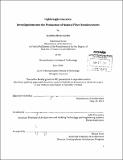| dc.contributor.advisor | John Fernandez. | en_US |
| dc.contributor.author | Garbis, Leonidia Maria | en_US |
| dc.contributor.other | Massachusetts Institute of Technology. Department of Architecture. | en_US |
| dc.date.accessioned | 2013-11-18T19:01:13Z | |
| dc.date.available | 2013-11-18T19:01:13Z | |
| dc.date.copyright | 2013 | en_US |
| dc.date.issued | 2013 | en_US |
| dc.identifier.uri | http://hdl.handle.net/1721.1/82261 | |
| dc.description | Thesis (S.B.)--Massachusetts Institute of Technology, Dept. of Architecture, 2013. | en_US |
| dc.description | Cataloged from PDF version of thesis. | en_US |
| dc.description | Includes bibliographical references (p. 34). | en_US |
| dc.description.abstract | The purpose of this study is to investigate the benefits of adding natural fiber tensile reinforcement to aerated concrete. Concrete is a great composite material which can be created in various proportions and with various materials to alter its strength, density and porosity, amongst other properties. Concrete which is used commonly in construction of columns, beams, and slabs acts well in compression but fails under tension. The common solution is to reinforce the structure in areas where it experiences tension with steel. There are other materials besides steel which also take tension well. Natural fibers for example come in various strengths and types and would create lighter and perhaps more sustainable beam designs. Natural fibers have been used for their availability, workability, and high tensile strengths for centuries. This research discovers how the natural fibers distribute within the mixture and how they affect the aeration of the concrete, as well as how they affect the strength. Multiple samples are cured with different fiber types and in different proportions within the mixture. Furthermore, similar experimentation is conducted to discover an ideal ratio of aggregate to aerated concrete mix. The aggregate gives the concrete greater strength and economy, but could negatively affect the aeration. The various concrete mixes are poured and allowed to cure to maximum strength before indirect tensile tests and compression tests are conducted. The effects of creating smooth aerated concrete molds are also investigated. All experiments conducted are precursory to an ultimate tensile reinforced aerated concrete beam design with an aggregate mix and smooth surfaces. | en_US |
| dc.description.statementofresponsibility | by Leonidia Maria Garbis. | en_US |
| dc.format.extent | 57 p. | en_US |
| dc.language.iso | eng | en_US |
| dc.publisher | Massachusetts Institute of Technology | en_US |
| dc.rights | M.I.T. theses are protected by
copyright. They may be viewed from this source for any purpose, but
reproduction or distribution in any format is prohibited without written
permission. See provided URL for inquiries about permission. | en_US |
| dc.rights.uri | http://dspace.mit.edu/handle/1721.1/7582 | en_US |
| dc.subject | Architecture. | en_US |
| dc.title | Lightweight concrete : investigations into the production of natural fiber reinforcement | en_US |
| dc.title.alternative | Investigations into the production of natural fiber reinforcement | en_US |
| dc.type | Thesis | en_US |
| dc.description.degree | S.B. | en_US |
| dc.contributor.department | Massachusetts Institute of Technology. Department of Architecture | |
| dc.identifier.oclc | 861185476 | en_US |
